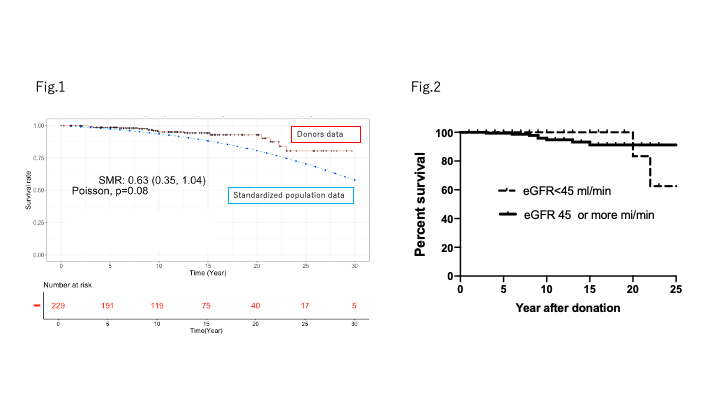Longitudinal Mortality Risks and Renal Functional Outcomes in Living Kidney Donors
1Urology, Hokkaido University Hospital, Sapporo, Japan, 2Biostatistics, Hokkaido University Graduate School of Medicine, Sapporo, Japan
Meeting: 2022 American Transplant Congress
Abstract number: 796
Keywords: Donation, Kidney transplantation, Outcome, Renal function
Topic: Clinical Science » Kidney » 39 - Kidney Living Donor: Long Term Outcomes
Session Information
Session Name: Kidney Living Donor: Long Term Outcomes
Session Type: Poster Abstract
Date: Saturday, June 4, 2022
Session Time: 5:30pm-7:00pm
 Presentation Time: 5:30pm-7:00pm
Presentation Time: 5:30pm-7:00pm
Location: Hynes Halls C & D
*Purpose: Previous studies have suggested that living kidney donors do not have a higher risk of death or end-stage kidney disease (ESKD) than the general population. However, recent studies have suggested that screened kidney donors have a higher risk of ESKD than matched healthy controls. Therefore, donor risk is controversial. Furthermore, only few studies have evaluated long-term renal function after kidney donation. We aimed to evaluate the long-term outcomes, including mortality and renal function, in Japanese kidney donors.
*Methods: We collected the data of 229 living kidney donors (76men, 153 women) who underwent nephrectomy between 1965 and 2015 at our hospital. The median age was 54 years (range, 26-75 years). We evaluated mortality, cause of death, ESKD incidence, and changes in renal function. To compare the donor cohort with the age- and gender-matched general population of the same period, we plotted survival curves and estimated standardized mortality ratios (SMR). The data on mortality in general population was obtained from Vital Statistics supplied by Japanese Ministry of Health, Labour, and Welfare.
*Results: The median follow-up period was 11.0 (range, 1-41) years. Survival analysis showed that 214 donors were still alive, and 15 died. The median interval between donation and death was 9.9 (2.0-32.8) years, and the median age at death was 70 (41-87) years. The following causes of death were observed: malignancies, 9; cardiovascular disease, 2; pneumonia, 1; suicide, 1; gastrointestinal bleeding, 1; and renal failure 1. Actual donor survival rates at 10, 20, and 30 years were 95.3%, 90.7%, and 80.9%, respectively; these values were comparable to age- and gender-matched expected survival (Fig.1). Next, we evaluated the renal function in 185 donors. During follow-up, two donors developed ESKD and 38 showed new-onset estimated glomerular filtration rates (eGFR) < 45ml/min after donation. The percentage of donors with eGFR > 45 ml/min at 10, 20, and 30 years were 84.1%, 72.7%, and 62.3%, respectively. However, the survival rates of donors with eGFR < 45 ml/min were comparable to those of donors with eGFR 45 or more ml/min. (Fig 2)
*Conclusions: Our data suggested that kidney donors did not have increased long-term risk of death compared to the general population. Although some donors showed decreased kidney function after donation, renal function had no impact on their survival.
To cite this abstract in AMA style:
Hotta K, Osawa T, Yokota I, Inao T, Tanabe T, Iwahara N, Shinohara N. Longitudinal Mortality Risks and Renal Functional Outcomes in Living Kidney Donors [abstract]. Am J Transplant. 2022; 22 (suppl 3). https://atcmeetingabstracts.com/abstract/longitudinal-mortality-risks-and-renal-functional-outcomes-in-living-kidney-donors/. Accessed December 12, 2025.« Back to 2022 American Transplant Congress

